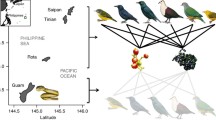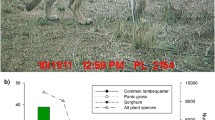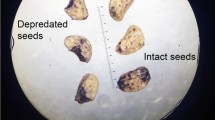Abstract
Vertebrates often mediate seed dispersal systems, essential for the maintenance of biodiversity. Some of these acquire a complex multistep process in island environments, where for example a native predatory bird can predate upon a frugivorous vertebrate, dispersing seeds secondarily. These complex mutualistic processes are really threatened by biological invasions especially on islands, due to the particular and intrinsic traits of their biotas. One of the most pernicious invasive mammals is the feral cat, widely introduced on at least 179,000 islands worldwide. Despite the potential impact of disruption of these complex seed dispersal processes, their ecological effects remain largely unknown. Therefore, the main aim of this contribution is to assess the impact of an invasive vertebrate on seed dispersal effectiveness at the crucial phases of plant recruitment: seed damage, viability, and germination. We designed a laborious captivity experiment with lizards and cats to simulate the four potential ways seeds could be dispersed in the wild: (1) control plants, (2) lizard droppings, (3) cat droppings and (4) cat droppings after consuming frugivorous lizards. We considered those four plant species whose seeds were the most abundant in feral cat droppings in all the main habitats of the Canary Islands. The main results indicated that (1) species with thicker seed coat better resisted abrasion caused by the digestive effect of the invasive cats and, (2) native and endemic species with thinner seed coats, that have not evolved with invasive mammals, suffered from a negative effect on seed effectiveness. To our knowledge, this is the first study reporting the potential disruptive impact of secondary seed dispersal systems caused by an invasive predator and one of the scant contributions evaluating seed dispersal effectiveness.


Similar content being viewed by others
References
Adams RP (2008) Junipers of the world: the genus Juniperus. Trafford Publishing, Vancouver
Aslan CE, Zavaleta ES, Tershy B, Croll D (2013) Mutualism disruption threatens global plant biodiversity: a systematic review. PLoS ONE 8:e66993
Barquín E, Nogales M, Wildpret W (1986) Intervención de vertebrados en la diseminación de plantas vasculares en Inagua, Gran Canaria (Islas Canarias). Vieraea 16:263–272
Bonnaud E, Medina FM, Vidal E, Nogales M, Tershy B, Zavaleta E, Donlan JC, Keitt B, Le Corre M, Horwath SV (2011) The diet of feral cats on islands: a review and a call for more studies. Biol Invasions 13:581–603
Clark CJ, Poulsen JR, Bolker BM, Connor EF, Parker VT (2005) Comparative seed shadows of bird-, monkeys-, and wind-dispersed trees. Ecology 86:2684–2694
Culliney S, Pejchar L, Switzer R, Ruiz-Gutierrez V (2012) Seed dispersal by a captive corvid: the role of the ´Alalá (Corvus hawaiiensis) in shaping Hawai´i´s plant communities. Ecol Appl 22:1718–1732
Fitzgerald BM (1988) Diet of domestic cats and their impact on prey populations. In: Turner DC, Bateson P (eds) The domestic cat: the biology of its behaviour. Cambridge University Press, Cambridge, pp 123–147
Godoy JA, Jordano P (2001) Seed dispersal by animals: exact identification of source trees with endocarp DNA microsatellites. Mol Ecol 10:2275–2283
Grant PR, Smith JNM, Grant BR, Abbott I, Abbott IK (1975) Finch numbers, owl predation and plant dispersal on Isla Daphne Major, Galapagos. Oecologia 19:239–257
Hansen DM, Müller CB (2009) Invasive ants disrupt gecko pollination and seed dispersal of the endangered plant Roussea simplex in Mauritius. Biotropica 41:202–208
Heleno R, Blake S, Jaramillo P, Traveset A, Vargas P, Nogales M (2011) Frugivory and seed dispersal in the Galápagos: what is the state of the art? Integr Zool 6:110–128
Heleno RH, Olesen JM, Nogales M, Vargas P, Traveset A (2013) Seed dispersal networks in the Galápagos and the consequences of alien plant invasions. Proc R Soc B Biol Sci 280:20122112
Herrera CM, Pellmyr O (2002) Plant-animal interactions: an evolutionary approach. Blackwell, Oxford
Hervías S, Oppel S, Medina FM, Pipa T, Díez A, Ramos JA, Ruiz de Ybáñez R, Nogales M (2014) Assessing the impacts of introduced cats (Felis catus) on island biodiversity by combining dietary and movement analysis. J Zool 292:39–47
Hulme PE, Brundu C, Camarda I, Dalias P, Lambdon P, Lloret F, Medail F, Moragues E, Suehs C, Traveset A, Troumbis A, Vilà M (2008) Assesing the risks to Mediterranean islands ecosystems from non-native plant introductions. In: Tokarska-Guzik B, Brock JH, Brundu C, Child L, Daehler CC, Pyšek P (eds) Plant invasions: human perception, ecological impacts and management. Backhuys, Leiden, pp 39–56
Kawakami K, Mizusawa L, Higuchi H (2009) Re-established mutualism in a seed-dispersal system consisting of native and introduced birds and plants on the Bonin Islands, Japan. Ecol Res 24:741–748
López-Darias M, Nogales M (2008) Effects of the invasive Barbary ground squirrel (Atlantoxerus getulus) on seed dispersal systems of insular xeric environments. J Arid Environ 72:926–939
Markl JS, Schleuning M, Forget PM, Jordano P, Lambert JE, Traveset A, Wright SJ, Böhning-Gaese K (2012) Meta-analysis of the effects of human disturbance on seed dispersal by animals. Conserv Biol 26:1072–1081
Medina FM, Nogales M (1993) Dieta del gato cimarrón (Felis catus L.) en el piso basal del Macizo de Teno (Noroeste de Tenerife). Doñana Acta Vertebrata 20:291–297
Medina FM, García R, Nogales M (2006) Feeding ecology of feral cats on a heterogeneous subtropical oceanic island (La Palma, Canarian Archipelago). Acta Theriol 51:75–83
Medina FM, López-Darias M, Nogales M, García R (2008) Food habits of feral cats (Felis silvestris f. catus, L. 1758) in insular semiarid environments (Fuerteventura, Canary Islands). Wildl Res 35:162–169
Medina FM, Bonnaud E, Vidal E, Tershy BR, Zavaleta ES, Donlan CJ, Keitt BS, Le Corre M, Horwath SV, Nogales M (2011) A global review of the impacts of invasive cats on island endangered vertebrates. Glob Chang Biol 17:3503–3510
Medina FM, Bonnaud E, Vidal E, Nogales M (2014) Underlying impacts of invasive cats on islands: not only a question of predation. Biodivers Conserv 23:327–342
Meehan HJ, McConkey KR, Drake DR (2002) Potential disruptions to seed dispersal mutualisms in Tonga, Western Polynesia. J Biogeogr 29:695–712
Molina Borja M (1985) Spatial and temporal behaviour of Galotia galloti in a natural population of Tenerife. Bonner zoologische Beiträge 36:541–552
Nogales M, Medina FM (1996) A review of the diet of feral domestic cats (Felis silvestris f. catus) on the Canary Islands, with new data from the laurel forest of La Gomera. Zeitschrift für Säugetierkunde 61:1–6
Nogales M, Medina FM (2009) Trophic ecology of feral cats (Felis silvestris f. catus) in the main environments of an oceanic archipelago (Canary Islands): an updated approach. Mamm Biol 74:169–181
Nogales M, Martín A, Delgado G, Emmerson K (1988) Food spectrum of the feral cat (Felis catus L., 1758) in the juniper woodland on El Hierro (Canary Islands). Bonner zoologische Beiträge 39:1–6
Nogales M, Abdola M, Alonso C, Quilis V (1990) Premiêres données sur l’alimentation du chat haret (Felis catus L., 1758) du Parc National du Teide. Ténérife (Iles Canaries). Mammalia 54:189–196
Nogales M, Valido A, Medina FM (1995) Frugivory of Plocama pendula (Rubiaceae) by the Rabbit (Oryctolagus cuniculus) in xerophytic zones of Tenerife (Canary Islands). Acta Oecologica 16:585–591
Nogales M, Medina FM, Valido A (1996) Indirect seed dispersal by the Feral Cat (Felis catus) in island ecosystems (Canary Islands). Ecography 19:3–6
Nogales M, Hernández EC, Valdés F (1999) Seed dispersal by Common Ravens Corvus corax among island habitats (Canarian Archipelago). Écoscience 6:56–61
Nogales M, Quilis V, Medina FM, Mora JL, Trigo LS (2002) Are predatory birds effective secondary seed dispersers? Biol J Linn Soc 75:345–352
Nogales M, Nieves C, Illera JC, Padilla DP, Traveset A (2005) Effect of native and alien vertebrate frugivores on seed viability and germination patterns of Rubia fruticosa (Rubiaceae) in the eastern Canary Islands. Funct Ecol 19:429–436
Nogales M, Padilla DP, Nieves C, Illera JC, Traveset A (2007) Secondary seed dispersal systems, frugivorous lizards and predatory birds in insular volcanic badlands. J Ecol 95:1394–1403
Nogales M, González-Castro A, Marrero P, Bonnaud E, Traveset A (2013) Contrasting selective pressures on seed traits of two congeneric species by their main native guilds of dispersers on islands. PLoS ONE 8:e63266
Nuñez MA, Hayward J, Horton TR, Amico GC, Dimarco RD, Barrios-García MN, Simberloff D (2013) Exotic mammals disperse exotic fungi that promote invasion by exotic trees. PLoS ONE 8:e66832
Padilla DP, Nogales M (2009) Behavior of kestrel feeding on frugivorous lizards: implications for secondary seed dispersal. Behav Ecol 20:872–877
Padilla DP, González-Castro A, Nogales M (2012) Significance and extent of secondary seed dispersal by predatory birds on oceanic islands: the case of the Canary archipelago. J Ecol 100:416–427
Padrón B, Nogales M, Traveset A, Vilà M, Martínez-Abraín A, Padilla DP, Marrero P (2011) Integration of invasive Opuntia spp. by native and alien seed dispersers in the Mediterranean area and the Canary Islands. Biol Invasions 13:831–844
Reyes-Agüero JA, Aguirre JR, Valiente-Banuet A (2006) Reproductive biology of Opuntia: a review. J Arid Environ 64:549–585
Rice WR (1989) Analyzing tables of statistical tests. Evolution 43:223–225
Robbins CT (1993) Wildlife feeding and nutrition. Academic Press, San Diego
Rodríguez A, Nogales M, Nieves C (2006) Germination responses of the Rubia fruticosa Ait. seed dispersal system in different experimental seasons. Afr J Ecol 45:361–364
Rodríguez A, Rodríguez B, Rumeu B, Nogales M (2007) Seasonal diet of the Grey Heron Ardea cinerea on an oceanic island (Tenerife, Canary Islands): indirect interaction with wild seed plants. Acta Ornithologica 42:77–87
Rodríguez A, Nogales M, Rumeu B, Rodríguez B (2008) Temporal and spatial variation in the diet of the endemic lizard Gallotia galloti in an insular Mediterranean scrub-land. J Herpetol 42:213–222
Rodríguez-Cabal MA, Stuble CKL, Guénard B, Dunn RR, Sanders NJ (2011) Disruption of ant-seed dispersal mutualisms by the invasive Asian needle ant (Pachycondyla chinensis). Biol Invasions 14:557–565
Rodríguez-Pérez J, Traveset A (2010) Seed dispersal effectiveness in a plant-interaction and its consequences for plant regeneration after disperser loss. Plant Ecol 207:269–280
Rumeu B, Nogales M, Elias RB, Padilla DP, Resendes T, Rodríguez A, Valdés F, Dias E (2009) Contrasting phenology and female cone characteristics of the two Macaronesian island endemic cedars (Juniperus cedrus and J. brevifolia). Eur J Forest Res 128:567–574
Rumeu B, Elias RB, Padilla DP, Melo C, Nogales M (2011) Differential seed dispersal systems of endemic junipers in two oceanic Macaronesian archipelagos: the influence of biogeographic and biological characteristics. Plant Ecol 212:911–921
Santana F, Martín A, Nogales M (1986) Datos sobre la alimentación del gato cimarrón (Felis catus Linnaeus, 1758) en los montes de Pajonales, Ojeda e Inagua (Gran Canaria). Vieraea 16:113–117
Scharpf RF (1970) Seed viability, germination and radicle growth of Dwarf Mistletoe in California. Research paper PSW-59. USDA Forest Service of California, USA
Schupp EW (1993) Quantity, quality and the effectiveness of seed dispersal by animals. In: Flemming T, Estrada A (eds) Frugivory and seed dispersal: ecological and evolutionary aspects. Kluwer, Dordrecht, pp 15–29
Schupp EW, Jordano P, Gómez JM (2010) Seed dispersal effectiveness revisited: a conceptual review. New Phytol 188:333–353
Sparkes AH, Papasouliotis K, Barr FJ, Gruffydd-Jones TJ (1997) Reference ranges for gastrointestinal transit of barium-impregnated polyethylene spheres in healthy cats. J Small Anim Pract 38:340–343
Spotswood EN, Meyer J-Y, Bartolome JW (2012) An invasive tree alters the structure of seed dispersal networks between birds and plants in French Polynesia. J Biogeogr 39:2007–2020
Stevens CE (1988) Comparative physiology of the vertebrate digestive system. Cambridge University Press, New York
Stiles EW (2000) Animals as seed dispersers. In: Fenner M (ed) Seeds: the ecology of regeneration in plant communities. CAB International, Wallingford, pp 111–124
Traveset A, Richardson DM (2006) Biological invasions as disruptors of plant reproductive mutualisms. Trends Ecol Evol 21:208–216
Traveset A, Riera N (2005) Disruption of a plant-lizard seed dispersal system and its ecological effects on a threatened endemic plant in the Balearic Islands. Conserv Biol 19:421–431
Traveset A, Riera N, Mas RE (2001) Passage through bird gut causes interespecific differences in seed germination characteristics. Funct Ecol 15:669–675
Traveset A, González-Varo JP, Valido A (2012) Long-term demographic consequences of a seed dispersal disruption. Proc R Soc B 279:3298–3303
Traveset A, Heleno R, Nogales M (2013) The ecology of seed dispersal. In: Gallagher RS (ed) Seeds: the ecology of regeneration in plant communities. CAB International, Wallingford, pp 62–93
Valido A (1999) Ecología de la dispersión de semillas por los lagartos endémicos canarios (G. Gallotia, Lacertidae). Ph.D., University of La Laguna, Tenerife, Canary Islands
Valido A, Nogales M (1994) Frugivory and seed dispersal by the lizard Gallotia galloti (Lacertidae) in a xeric habitat of the Canary Islands. Oikos 70:403–411
Valido A, Nogales M (2003) Digestive ecology of two omnivorous Canarian lizard species (Gallotia, Lacertidae). Amphibia-Reptilia 24:331–344
Valido A, Olesen JM (2007) The importance of lizards as frugivores and seed dispersers. In: Dennis AJ, Schupp EW, Green RJ, Westcott DA (eds) Seed dispersal: theory and its application in a changing world. CAB International, Oxfordshire, pp 124–147
Valido A, Nogales M, Medina FM (2003) Fleshy fruits in the diet of Canarian lizard Gallotia galloti (Lacertidae) in a xeric habitat of the Island of Tenerife. J Herpetol 37:741–747
Acknowledgments
Graciela G. Nicola, Rocío A. Baquero, Patricia Marrero, Benito Pérez, Francisco Martín, Elena Morales and Heriberto López for their logistic support in different phases of the project. María Teresa García facilitated our research and convinced two of her domestic cats (Gris and Panchita) to participate in our experiments. The Cabildo de Tenerife granted the permit (Expte.: FYF 208/11; No. Sigma: 831/2011) to temporarily maintain lizards in captivity. This work was indirectly benefited by three projects funded by the Gobierno de Canarias (ProID20100258), Organismo Autónomo de Parques Nacionales, Ministerio de Medio Ambiente (051/2010) and Ministerio de Educación y Ciencia (CGL2010-18759).
Author information
Authors and Affiliations
Corresponding author
Rights and permissions
About this article
Cite this article
Nogales, M., Castañeda, I., López-Darias, M. et al. The unnoticed effect of a top predator on complex mutualistic ecological interactions. Biol Invasions 17, 1655–1665 (2015). https://doi.org/10.1007/s10530-014-0823-x
Received:
Accepted:
Published:
Issue Date:
DOI: https://doi.org/10.1007/s10530-014-0823-x




